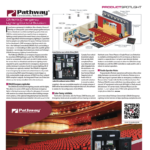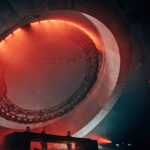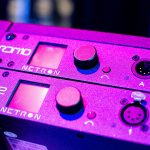While ETC’s newest lighting console is considered “new” by most standards, the parents of the system would say that the console has been in gestation for more than 30 years.
The true heritage of the console began with Avab, the Scandinavian lighting console manufacturer that, three decades ago, had one of the two existing 999- channel boards, the Viking. With a simple, direct-access control structure, the Avab brand has maintained a strong presence in European markets ever since.
Jump ahead to today, and an arranged marriage orchestrated by ETC’s Fred Foster has brought together Avab with industry leviathan ETC. With strong product histories on both sides of the aisle, the newlyweds decided to leverage ETC’s domestic brand and extensive resources while taking advantage of Avab’s proven technology and international user-base to create a new console with the features most requested by their users.
 The Hardware
The Hardware
Weighing in at just over 80 pounds with a footprint two feet deep and nearly four feet wide, the board features two builtin monitor arms that assist in reclaiming some of that highly valuable desk space, while supporting a total of three outboard displays. The innards of the desk include a Pentium M running at 1.6GHz and Windows XP Embedded behind the scenes. The board sports standard USB connections for input, storage devices, alphanumeric keyboards and pointing devices.
Two physical DMX-512 outputs are available at the rear of the desk, with expansion available via Ethernet using the manufacturer’s proprietary ETCNET2 protocol. The Ethernet connection can also be leveraged as a direct connection to third-party visualization software such as WYSIWYG and Capture, or to connect to file servers for show backup and collaboration.
 The left half of the control surface includes 40 master playbacks below 40 palette “direct selects,” while the right half of the console is broken up a bit more with programming keys and main playback controls appearing below the grand master, independent masters and a semi-dedicated moving light control surface.
The left half of the control surface includes 40 master playbacks below 40 palette “direct selects,” while the right half of the console is broken up a bit more with programming keys and main playback controls appearing below the grand master, independent masters and a semi-dedicated moving light control surface.
All keys and faders on the board appear to be of a very high quality, with only one real surprise in the layout: In the dead center of the console sits a back-lit trackball which, as it turns out, was put in the middle of the console not to draw attention to it, but to keep it out of reach. The console does, however, have navigation controls in the keypad, which are more readily accessible. (The buttons and keys are also relatively large, making them much easier to read at a glance. –Ed.)
     |
The Software
With a graphical interface that drives a middle road between other manufacturers’ color-saturated offerings and ETC’s own text-only displays, the visual output of the Congo is very easy to understand at first glance, and probably its strongest trait. System functions are accessed via a tree-like “browser” tab, with all subsequent information available via tabbed windows. A presumably unlimited number of tabs can be opened simultaneously, with each display showing its tabs full-screen, split in half vertically or split horizontally.
A zoomable channel sheet or “Live” tab anchors the array of available display options. For those heavily steeped in theatre, the available information should be a welcome change from the MS-DOS typefaces still seen every day, offering up basic channel intensity and color scroller values as well as easily discernible channel selections and record status. For those users who are coming from boards that offer data-intensive moving light displays, the GUI will be very easy to understand, but may not offer quite as much information at your fingertips as you are used to. Spreadsheet views abound throughout the system, but are not yet as thoroughly developed as competitors in this category.
The Method
The Avab style of programming is somewhat foreign to most programmers in the U.S., with a scheme that seems to sit right in-between today’s theatrical consoles and the more moving light-friendly or concert-oriented consoles on the market. While the concepts of a command line and a programmer do not exist in Congo, there is fairly strong support for live editing of cues and sequences.
The direct access input method is the hardest part of the console to learn, with a fairly strict command structure. The upside to this is that once learned, the structure becomes very extensible, with complex changes requiring fewer keystrokes than other consoles. Core to this technique is the goal of keeping the operator’s hands on the console at all times. Touchscreens are purposefully not offered as an input method, as the displays are strictly designed for visual feedback.
The Summary
Anyone who is looking for a console to take control of a theatrical style show with a lot of cues and more than a few movers should take a very serious look at this desk. Operators looking for the next rock ‘n’ roll board will probably not be blown away, though I would expect to see very large improvements to that side of this desk’s personality in the next year or two.
And finally, anyone operating media servers in any market should definitely take this desk for a spin. The 40-palette “direct selects” at the top left of the console cry out for quick work on a Catalyst or a Maxxedia.
 The Conclusion
The Conclusion
While only time will tell how this console does in the wild, the resources that ETC is putting behind it are a very good sign for the future of this platform.
Congo is destined to make waves in ETC’s currently-dominated theatre segment, and maybe even beyond.
Phil Gilbert is a freelance lighting designer/ programmer. He can be reached at pgilbert@plsn.com. Special thanks to Tall City Stage & Cinema of Chicago for kindly providing testing grounds.
ETC
800.688.4116
www.etcconnect.com


